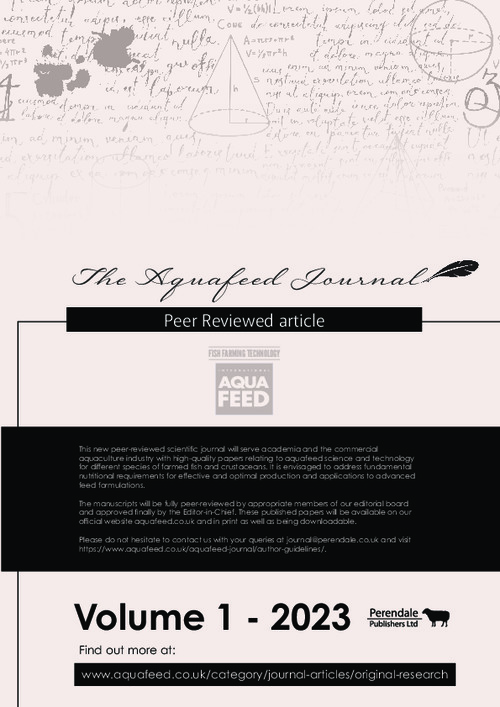Please use this identifier to cite or link to this item:
https://hdl.handle.net/20.500.12348/5868
Potential for producing tilapia (Oreochromis niloticus) feed using locally sourced ingredients in resource-poor farming systems: A case study from Timor-Leste (Oreochromis mossambicus)
| dc.creator | Pant, J. | en_US |
| dc.creator | Perera, D. | en_US |
| dc.creator | Jusadi, D. | en_US |
| dc.creator | Teoh, S. | en_US |
| dc.creator | Gomes, S. | en_US |
| dc.creator | Pandit, N. | en_US |
| dc.creator | Bhujel, R. | en_US |
| dc.creator | Timsina, J. | en_US |
| dc.date.accessioned | 2024-03-19T18:37:41Z | |
| dc.date.available | 2024-03-19T18:37:41Z | |
| dc.date.issued | 2023 | en_US |
| dc.identifier.citation | Jharendu Pant, Devamullage Ramesh Perera, Dedi Jusadi, Shwu Jiau Teoh, Silvino Gomes, Narayan P. Pandit, Ram C Bhujel, Jagadish Timsina. (6/7/2023). Potential for producing tilapia (Oreochromis niloticus) feed using locally sourced ingredients in resource-poor farming systems: A case study from Timor-Leste (Oreochromis mossambicus). International Aquafeed, 1. | en_US |
| dc.identifier.uri | https://hdl.handle.net/20.500.12348/5868 | |
| dc.description.abstract | The Timor-Leste National Aquaculture Development Strategy (NADS) articulates achieving food and nutrition security of its people by substantially increasing national fish production and per capita fish consumption through aquaculture by 2030. Achieving high fish production through aquaculture requires sustainable source of feed and nutrient inputs that can be produced locally. Fish feed should contain at least 20% crude protein. To augment the protein content, plant-based ingredients should be added with soybean or animal origin ingredients, the latter needing importation. Any feed mills dependent on the imported ingredients, however, may not be economically viable in Timor-Leste where aquaculture is just emerging. Aquaculture with Nile tilapia, with an ability to utilize green water and feed made up of mainly plant-based ingredients, has potential to achieve Timor-Leste’s fish production and consumption targets. This study aimed at developing fish feed from various formulation options based on locally available plant- and animal-source ingredients. A survey with farmers and diverse stakeholders followed by a feed formulation workshop were conducted to identify potential ingredients and formulate fish feed. The survey identified 26 plant and seven animal source ingredients based on seasonal or year-round availability for on‑farm feed preparation. The ingredients that could be used for fish feed included rice bran, corn bran, leucaena leaf meal, taro/cocoyam leaves, fresh cassava, and blood meal, which except the latter were of low protein and high fibre contents. In the workshop, four sets of commercial feed formulation options with 26-27% targeted protein content were developed using local and/or imported (fishmeal and soybean meal) ingredients . The feed formulation exercise revealed that producing feed containing only about 15% crude protein is possible using these ingredients, which could be raised up to 18% if blood meal is also included. The workshop also identified that support to private sector either for the import of high-quality feed ingredients in bulk for in-country feed production or for import of high-quality feed itself is crucial for meeting the NADS’s fish production and consumption targets through aquaculture. The study also suggests for exploring other alternatives such as in-country production of insect meals including the technical feasibility, economic viability, and environmental aspects for their mass-scale production. | en_US |
| dc.format | en_US | |
| dc.language | en | en_US |
| dc.publisher | Perendale Publushers Limited | en_US |
| dc.rights | CC-BY-4.0 | en_US |
| dc.source | International Aquafeed;1,(2023) | en_US |
| dc.title | Potential for producing tilapia (Oreochromis niloticus) feed using locally sourced ingredients in resource-poor farming systems: A case study from Timor-Leste (Oreochromis mossambicus) | en_US |
| dc.type | Journal Article | en_US |
| cg.contributor.funder | Ministry of Foreign Affairs and Trade (New Zealand) | en_US |
| cg.contributor.project | Partnership for Aquaculture Development in Timor-Leste (PADTL) Phase 2 | en_US |
| cg.coverage.country | Timor-Leste | en_US |
| cg.coverage.region | South-Eastern Asia | en_US |
| cg.subject.agrovoc | aquaculture | en_US |
| cg.subject.agrovoc | feed formulation | en_US |
| cg.subject.agrovoc | tilapia | en_US |
| cg.subject.agrovoc | fish feeds | en_US |
| cg.subject.agrovoc | fish | en_US |
| cg.contributor.affiliation | WorldFish | en_US |
| cg.contributor.affiliation | Asian Institute of Technology | en_US |
| cg.contributor.affiliation | Bogor Agricultural University | en_US |
| cg.contributor.affiliation | Agriculture and Forestry University | en_US |
| cg.contributor.affiliation | Institute for Study and Development Worldwide | en_US |
| cg.identifier.status | Open access | en_US |
| cg.contribution.worldfishauthor | Pant, J. | en_US |
| cg.contribution.worldfishauthor | Perera, D. | en_US |
| cg.contribution.worldfishauthor | Teoh, S. | en_US |
| cg.contribution.worldfishauthor | Gomes, S. | en_US |
| cg.description.theme | Sustainable aquaculture | en_US |
| cg.identifier.url | https://www.aquafeed.co.uk/potential-for-producing-tilapia-oreochromis-niloticus-feed-using-locally-sourced-ingredients-in-resource-poor-farming-systems-a-case-study-from-timor-leste/ | en_US |
| cg.creator.id | Shwu Jiau Teoh: 0000-0001-7676-8583 | en_US |
Files in this item
This item appears in the following Collection(s)
-
Sustainable aquaculture [2735]
